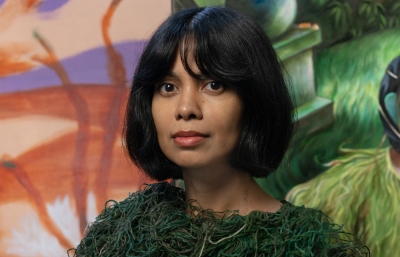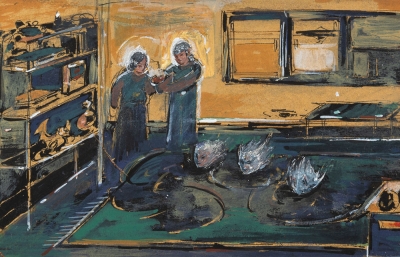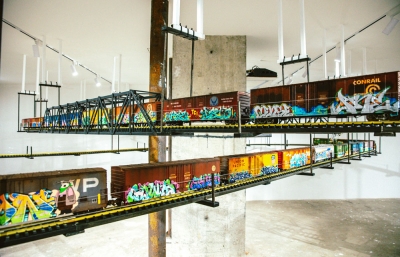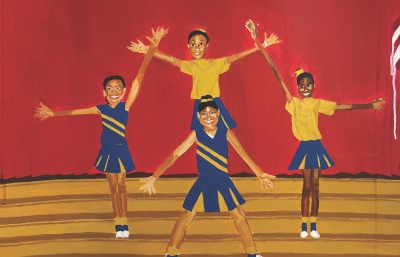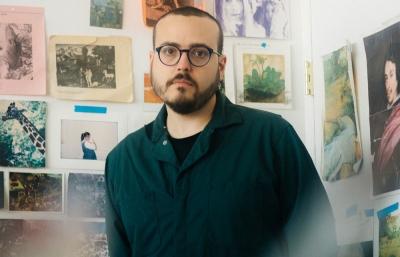Where exploration of the psychosomatic diversity that bends and distorts life's realities takes place, artist Jesse Draxler lives and works. He speaks to the uncomfortable individuals who, in his own words, breathe in a world of profound confusion, raptured by their own "best" thoughts. His artwork is an authentic look into the transitional stasis of a technologically saturated existence, and the lapse of connection, far from bridged within its void. Gesture is emotion, and emotion is yearned for. Through painting and collage, Jesse maneuvers his way in and out of a fabricated world of characters hungry to be understood.
Portrait by J Whitaker
Mike Carney: Being an artist, illustrator and art director, do you see these as three separate practices that define you as a maker, or have they amalgamated into one art practice?
Jesse Draxler: They all merge. A lot of the stuff I do commercially could easily be considered fine art if it were put into a gallery. If you put a piece on a panel and hang it in a gallery for an exhibition, it's fine art. If it's published in a magazine alongside an article, it's an illustration. But it could be the exact same piece. I use illustration commissions as practice for my fine art, and most of what I art direct makes its way onto a panel at some point. So the lines are definitely blurred between all practices.
Absolutely, it's all about context. Whether in a magazine, in a collector's home, on a gallery wall or existing in a social media setting, the work will carry different connotations. Your online presence almost seems like an extension of your practice. Although, I'm not sure if it's you trying to connect with the viewer, or if it's an opportunity for the viewer to connect with your work.
I think a lot of my work is looking for a reaction. At least for me, I want the person looking at a piece to feel what I feel, right? And if I'm not achieving that goal, then it's something of a failure. I’m definitely not one to make work for an audience, though. Regardless of whether anyone will ever even see the work, it all comes from a deeply personal place.
Sure, it's a question of sincerity and truths.
I used to be embarrassed about this, but I think recognition from other people is important. If I'm not getting the “likes,” it means the work I felt was strong enough to share isn't resonating with the audience, although many factors must be taken into account when analyzing likes. I'm currently reading this book that talks about, with a scientific approach, how the knowledge of our own mortality dictates everything we do. There is a chapter on self-esteem. In this case, they consider self-esteem to be one’s perception of how one is regarded amongst their peers. All these studies directly point to the fact that if someone has higher self-esteem, they have lower anxiety. It validates my feelings, in a way.
Right. It's totally different to talk about emotions in a sentient way, as opposed to a scientific way. As human beings, we are subject to our own best and worst thinking. That's all we get.
That, itself, is terrifying, always second guessing yourself. You can spend an entire day alone and not know if anything that you told yourself is true. That, to me, is really scary. Even scarier is then understanding that there is no “truth,” only perception. Scary may not be the proper word here, but it's a jarring realization.
I'm curious to know how that notion makes its way into your art practice.
Those are the sort of feelings I strive to portray, that uncertainty, fear, and surrender. I want to portray them in a way that when you look at the work, you feel it. A lot of times these emotions can't be put into words, and can only be expressed through pictures. Like when listening to music, I can't describe the feelings that arise when I listen, they can only be expressed through the music. So, the feelings that I'm trying to make art about draw from places that are adjacent to the likes of anxiety and depression, although I hate those words as they are just generalized labels. I think of them more as voids or questions. I've had these feelings pretty much all my life, and there are no words that properly describe what it feels like. More than anything, that's the underlying tone of all my work. So, when I start asking the question, "What is wrong with my brain?” it's mostly just confusion, and then eventually a void. It’s an empty feeling, not knowing anything, which then leads to a sense of nihilism, where you can't figure anything out, so nothing matters anymore. I think my works live in the interlude between these thought patterns. It's a constant feedback loop in an endless deep tunnel, a slight droney headache, like the hum of a refrigerator.
---
Read the full interview in the February, 2016 issue of Juxtapoz, on sale now.
Jesse Draxler's new show Terror Management opens at Booth Gallery in New York on January 9th, 2016.








